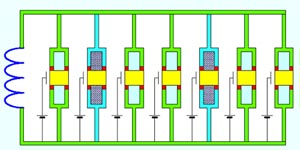Paper discusses circuitry for quantum computing

The next radically different means of information processing will be quantum computing, which researchers say will use the principles of quantum mechanics to perform complex calculations in a fraction of the time needed by the world’s fastest supercomputers.
A paper published recently in Physical Review Letters (Nov. 4 issue) has proposed an experimentally realizable circuit and an efficient scheme to implement scalable quantum computing. The ability to scale up the technology from the one or two-qubit experiments that are common in the laboratory to systems involving many qubits is what will finally make it possible to actually build a quantum computer.
“Scalable quantum computing with Josephson charge qubits,” was written by Franco Nori of the University of Michigan Physics Department and the Institute of Physical and Chemical Research (RIKEN) and two colleagues, J.Q. You from RIKEN and J.S. Tsai from RIKEN and the NEC Fundamental Research Laboratories.
Quantum computing is very different from the standard computers used today. Today’s computers process information using bits, each one equal to either 0 or 1. Quantum information processing uses quantum versions of these bits, individual atoms or subatomic particles called qubits. These qubits can be equal to 0, to1, or even both 0 and 1 at the same time. The ability to manipulate these superpositions of 0 and 1 is what will allow quantum computers to process complex information so quickly, since any given qubit can occupy either position.
In order to implement quantum information technology, it will be necessary to prepare, manipulate and measure the fragile quantum state of a system. “The first steps in this field have mostly focused on the study of single qubits,” Nori said. “But constructing a large quantum computer will mean scaling up to very many qubits, and controlling the connectivity between them. These are two of the major stumbling blocks to achieving practical quantum computing and we believe our method can efficiently solve these two central problems. In addition, a series of operations are proposed for achieving efficient quantum computations.
“We have proposed a way to solve a central problem in quantum computing – how to select two qubits, among very many, and make them interact with each other, even though they might not be nearest neighbors, as well as how to perform efficient quantum computing operations with them,” Nori said. Diagrams illustrating the operation of the system can be seen at http://www.umich.edu/~newsinfo/Releases/2002/Oct02/img/micro2.gif
A copy of the paper (no. 197902) can be found here. For more information, contact Franco Nori at nori@umich.edu or visit www.physics.lsa.umich.edu/nea/ and www.riken.go.jp/.
The University of Michigan
News Service
412 Maynard
Ann Arbor, MI 48109-1399
Media Contact
All latest news from the category: Information Technology
Here you can find a summary of innovations in the fields of information and data processing and up-to-date developments on IT equipment and hardware.
This area covers topics such as IT services, IT architectures, IT management and telecommunications.
Newest articles

NASA: Mystery of life’s handedness deepens
The mystery of why life uses molecules with specific orientations has deepened with a NASA-funded discovery that RNA — a key molecule thought to have potentially held the instructions for…

What are the effects of historic lithium mining on water quality?
Study reveals low levels of common contaminants but high levels of other elements in waters associated with an abandoned lithium mine. Lithium ore and mining waste from a historic lithium…

Quantum-inspired design boosts efficiency of heat-to-electricity conversion
Rice engineers take unconventional route to improving thermophotovoltaic systems. Researchers at Rice University have found a new way to improve a key element of thermophotovoltaic (TPV) systems, which convert heat…



